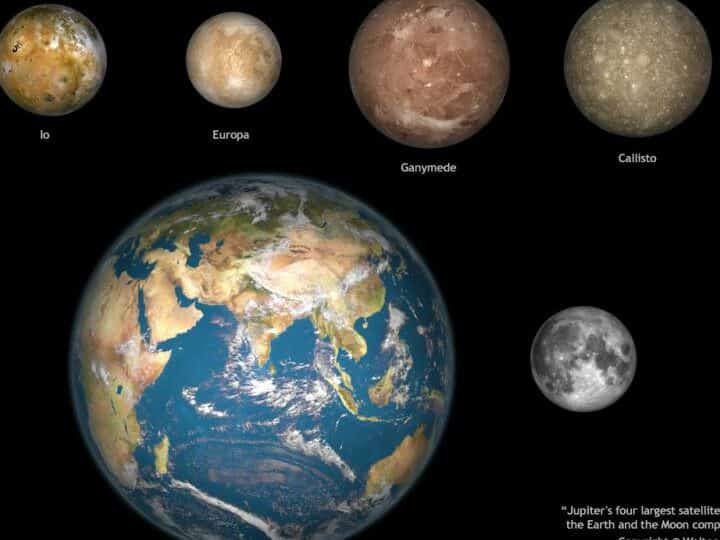Europa is one of the moons in the Galilean group orbiting Jupiter. It is located 6 positions away from the center of its system and has a surface covered in ice, with the possibility of warm water underneath. This moon is highly regarded as a potential destination for colonization by humans from Earth.
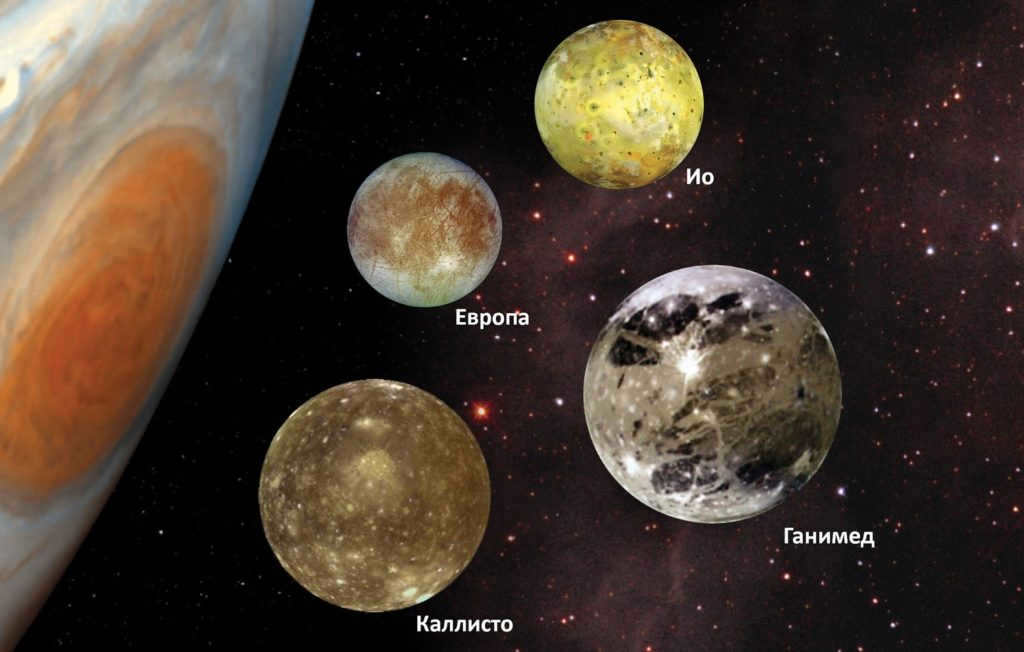
The Europa Satellite’s Discovery and Naming
In January 1610, the Europa satellite, along with three other satellites, was first observed by Galileo Galilei. Simon Marius, a German astronomer, also claimed to have discovered this celestial object. He stated that he had observed this group of heavenly bodies before Galileo, in late 1609. Marius proposed naming the moons of Jupiter after characters from Greek mythology. Europa was the name he chose for one of these moons, which was inspired by a Phoenician noblewoman named Europa. She was the daughter of the King of Tyre and later became the Queen of Crete.
Dimensions, weight, and path of revolution
With a radius of 1560 km, Europa is approximately 25% the size of planet Earth. Its mass is equivalent to 45 quintillion tons (a number with 18 zeros), which is less than 1% of Earth’s mass.
The satellite’s orbit takes on an almost perfectly circular shape, with a mean semi-axis (radius) of approximately 671 thousand kilometers. While there may be periods of non-synchronous rotation, it is generally believed that Europa always presents the same face to Jupiter. This phenomenon is not uncommon within the solar system, as Saturn, Uranus, and Neptune also possess similar moons.
The satellite completes a full orbit around the planet at a velocity of 50 thousand kilometers per hour, which takes approximately 3.5 Earth days. It interacts with two adjacent satellites, whose gravitational pull creates tides on Europa. This close proximity may be responsible for the heating of the inner ocean and the triggering of tectonic activities.
This celestial body has an estimated age of 4.5 billion years.
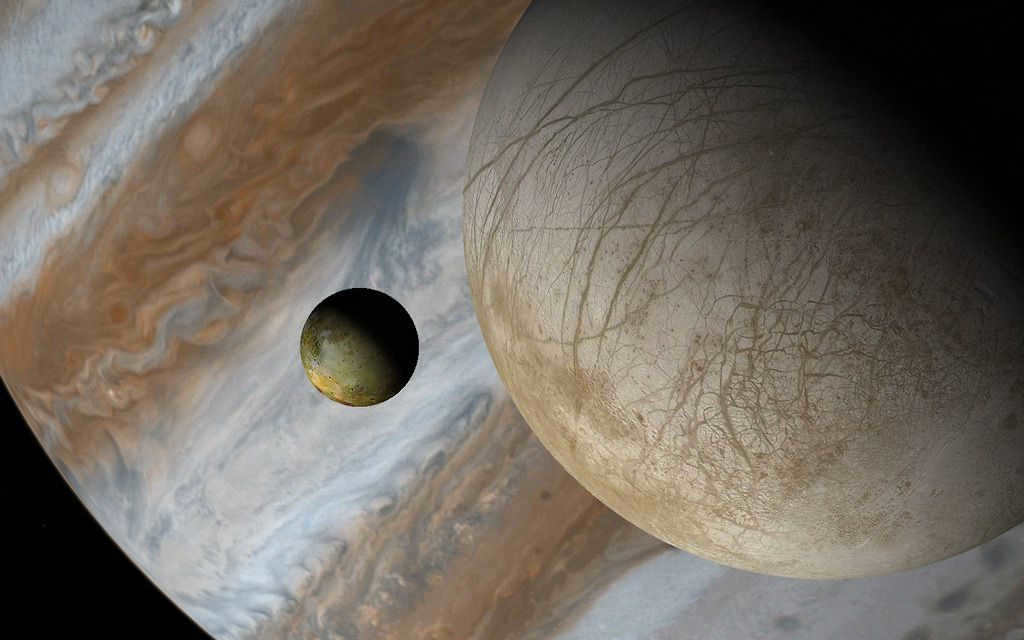
Europa’s Composition and Surface
Europa is made up of a dense solid material, with a density above 3 g/cm³. Scientists believe that it consists of a massive rocky core, a significant amount of silicate rocks, and an iron core. The surface of this moon is covered by a layer of ice, which can be as thick as 10-30 kilometers.
Europa is known for having one of the smoothest surfaces in the entire solar system. It is also highly reflective, with a light-reflecting coefficient of 0.64 (the highest albedo value among all the moons in the solar system).
There are formations called penitents along the equator of Europe. These are small ice peaks, measuring up to 10 meters in height, that are created either by solar radiation or by the eruption of ice at higher temperatures. These penitents are arranged in lines that can stretch up to 20 kilometers in length, and their edges are scattered and have a dark color.
Another notable feature of this area is the presence of dome-shaped formations that are elliptical in shape and no more than a few hundred meters in height. The tops of these elevations resemble ancient plains. The number of mountains and craters in this region is relatively small, which can be attributed to the relatively young top layer. It is believed that this top layer has existed in its current form for anywhere between 20 to 180 million years.
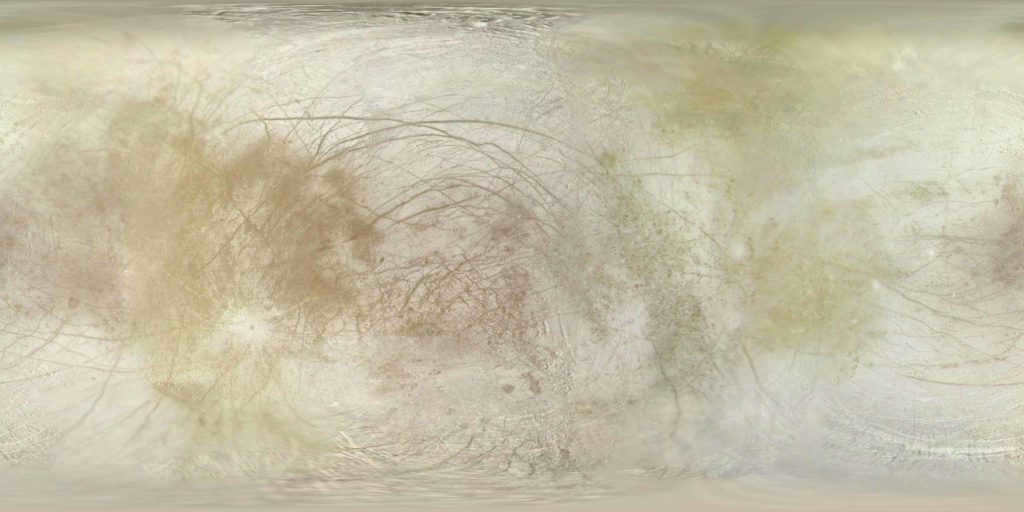
The satellite’s atmospheric composition
In 1995, scientists discovered a tenuous atmosphere on Europa, primarily composed of oxygen. However, this oxygen is believed to have formed through a process called radiolysis, where ultraviolet radiation breaks down the ice into oxygen and hydrogen ions. It is unlikely that this atmosphere is of biological origin.
Unfortunately, Europa’s atmosphere is not sufficient to shield the satellite from the harsh radiation of space. The surface radiation levels are so high that they would be lethal to any form of life. The equatorial temperature on Europa is a chilling -160°C, while the poles can reach an even colder -220°C.
A vast expanse of liquid water discovered on Europa
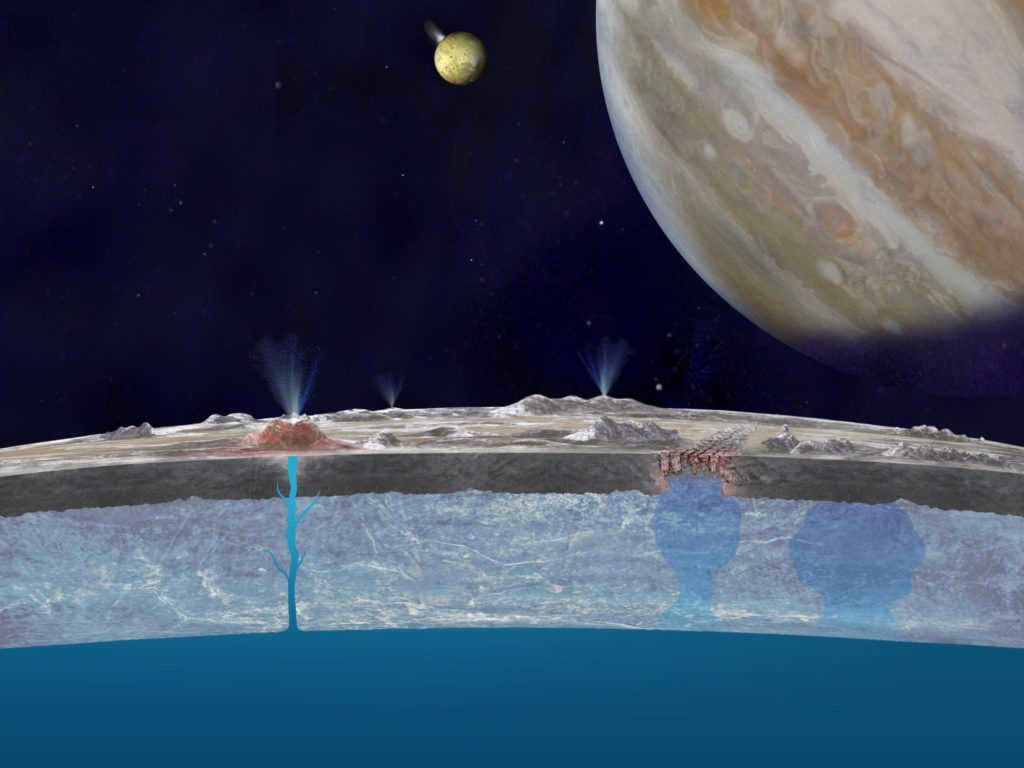
There is a potential existence of a global liquid ocean between the icy layer and the rocky portion of the moon.
This is indicated, for instance, by the unique surface features. Additionally, the research probes have detected a reddish-brown hue accompanying the limited tectonic faults.
An analysis of the spectrograph has confirmed the presence of significant amounts of salts in these regions, which could have formed as a result of water evaporation.
The presence of fresh ice deposits in certain areas of the moon further suggests the presence of a subsurface ocean. Unusual objects resembling water jets have been observed multiple times on Europa.
Existence on Europa, Jupiter’s Moon
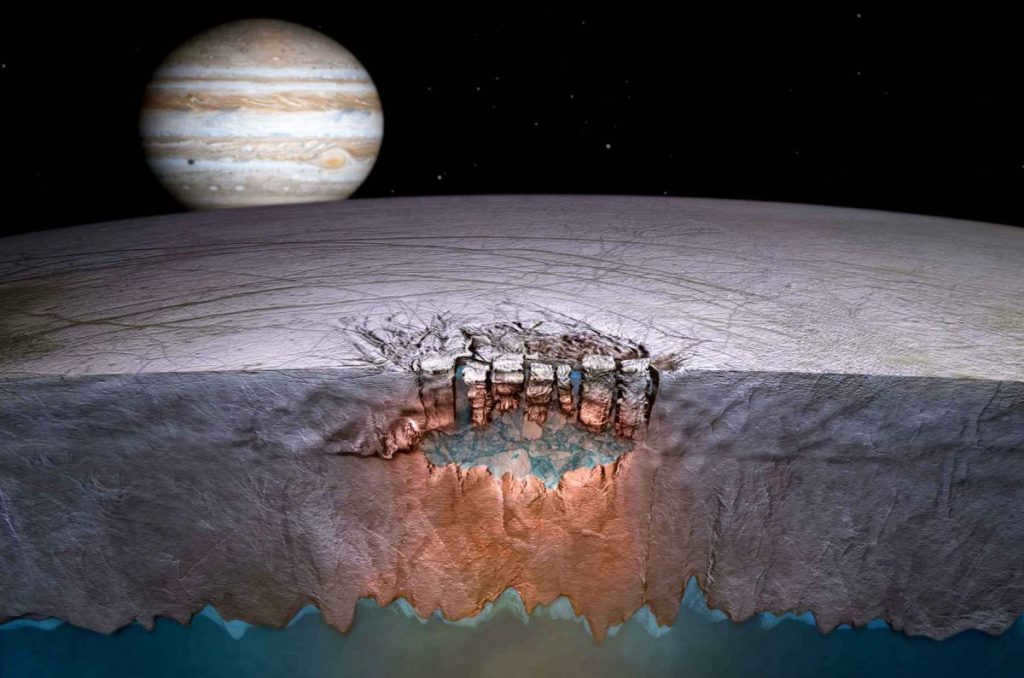
Europa, one of Jupiter’s moons, holds great promise for the discovery of extraterrestrial life. Scientists believe that life could potentially exist in Europa’s warm air currents and subsurface ocean.
One of the reasons Europa is considered a promising candidate for life is because its surface is in contact with a possible inner ocean. This allows air to enter the water, where oxygen can activate biological processes.
However, there are two main obstacles to the emergence of life on Europa:
Currently, scientists have not been able to confirm or deny these two conditions.
In 2015, there were reports suggesting the presence of oxygen in Europa’s water. Additionally, hydrogen peroxide, which could serve as a potential energy source for bacteria, was discovered on Europa a few years prior.
Colonizing Europa: A Possible Future
Europa, one of Jupiter’s moons, has long been considered a potential candidate for hosting a colony from Earth. Its inner ocean, although challenging to access due to the need for drilling ultra-deep wells, holds great promise as a valuable source of water, air, and even rocket fuel for the settlers.
Creating a livable environment on Europa will necessitate the establishment of an atmosphere. Scientists have proposed a fascinating method to achieve this: by utilizing ice sublimation, which can be induced through targeted rocket strikes and other innovative techniques to raise the surface temperature.
The most effective method of traversing the frozen surface of the moon is by using a vehicle, propelled not by a traditional sail (as there are no winds present), but by some form of propulsion system. Alternatively, it may be possible to modify a specialized sail structure to harness the power of the solar wind. In order to protect the vehicle from radiation, the hull should be shielded as much as possible, and the skids should be wide and long to navigate the numerous fractures and cracks in the local ice.
Among the challenges faced by potential colonizers is the presence of radioactive radiation from Jupiter, which has the potential to cause death within a day. The solution to this issue is to establish settlements beneath the ice cover.
Due to the moon’s minimal gravity, residents will experience rapid physical weakness, muscle atrophy, and bone deterioration.
Research on Jupiter’s moon Europa
The initial exploration of Europa began with the Pioneer-10 and Pioneer-11 missions in 1973-1974. The Voyager spacecraft then captured the first high-resolution images of the moon’s surface in 1979. In 1995, the Galileo program was launched and it conducted an extensive eight-year study, gathering detailed information about the physical and chemical properties of Europa.
The Galileo probe even managed to approach Europa at an unprecedentedly close distance of approximately 200 km. However, to prevent any potential contamination from Earth’s microbes, the probe was intentionally destroyed in the atmosphere of Jupiter, the planet that Europa orbits.
- In 1994, the Hubble telescope made a significant discovery by detecting the presence of oxygen in Europa’s local atmosphere.
- In 1999-2000, the Chandra space observatory detected X-rays coming from Europa.
- In 2000, the Cassini spacecraft, on its mission to Saturn, also collected data on Europa.
- In 2007, the New Horizons station received the next set of photographs of the object.
There are various initiatives underway to further explore the moon. One plan involves the development of an atomic device, designed to melt the ice crust in order to reach the ocean. Following this, another probe will be sent to investigate the water. The Europa Clipper project is set to commence in 2020. Additionally, the American and European space agencies – NASA and ESA – are collaborating on a program called “Laplace”. The JUICE station will make a flyby in 2030.
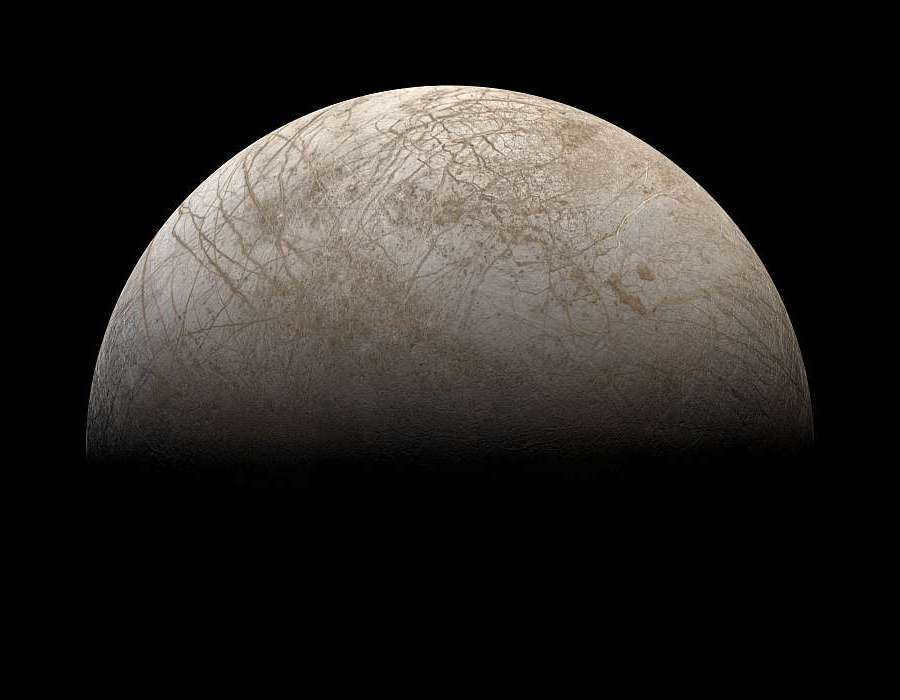
Europa, discovered by the Italian scientist and astronomer Galileo Galilei in 1610, is the smallest of the four satellites of Jupiter. It is also one of the largest satellites of planets in the solar system, although its size is slightly smaller than the Moon.
After discovering Europa and three other satellites of Jupiter, Galileo Galilei assigned them serial numbers and referred to this group of celestial bodies as the “Medici planets”.
The second moon of the planet Jupiter, known as the smallest of the “Galilean Moons”, was officially designated as Europa. This name was proposed in 1614 by Simon Marius, who also claimed to have been the discoverer of this moon, according to the available records. However, it wasn’t until the mid-20th century that the name Europa began to be commonly used. Europa, the smallest satellite of Jupiter, is named after Zeus’s (Jupiter’s) beloved in ancient Greek mythology.
Characteristics of the body
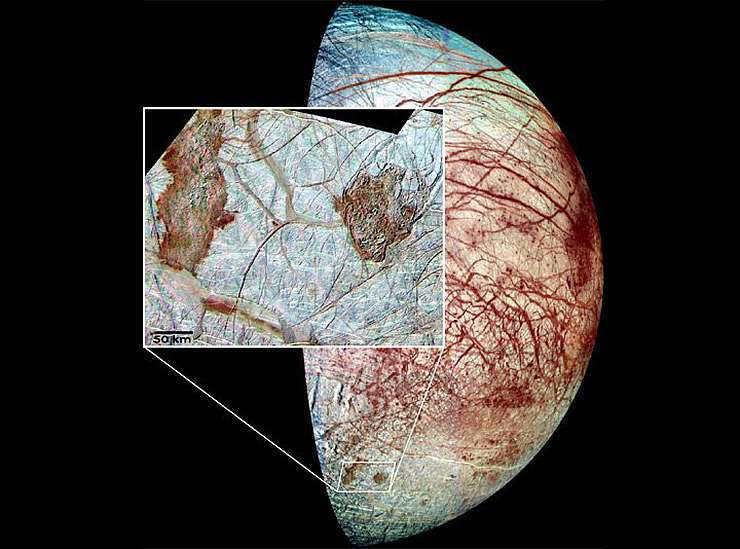
The entire expanse is enveloped in a intricate lattice of fragmented ice
One of the captivating attributes that Europa, one of Jupiter’s satellites, possesses is its perpetual orientation towards its host planet. Its physical and geological characteristics bear a closer resemblance to the terrestrial planets, which are predominantly composed of rock, as opposed to other “ice-enshrouded satellites”. The surface temperature of Europa, concealed beneath a presumed layer of water spanning 100 km and encased by an ice shell measuring approximately 10-30 km in thickness, plummets to a bone-chilling 150-190 degrees Celsius below zero. Europa is comprised of a diminutive metallic core encased in rock, which itself is encased in vast quantities of water and liquid ice sourced from the subsurface ocean.
Investigation
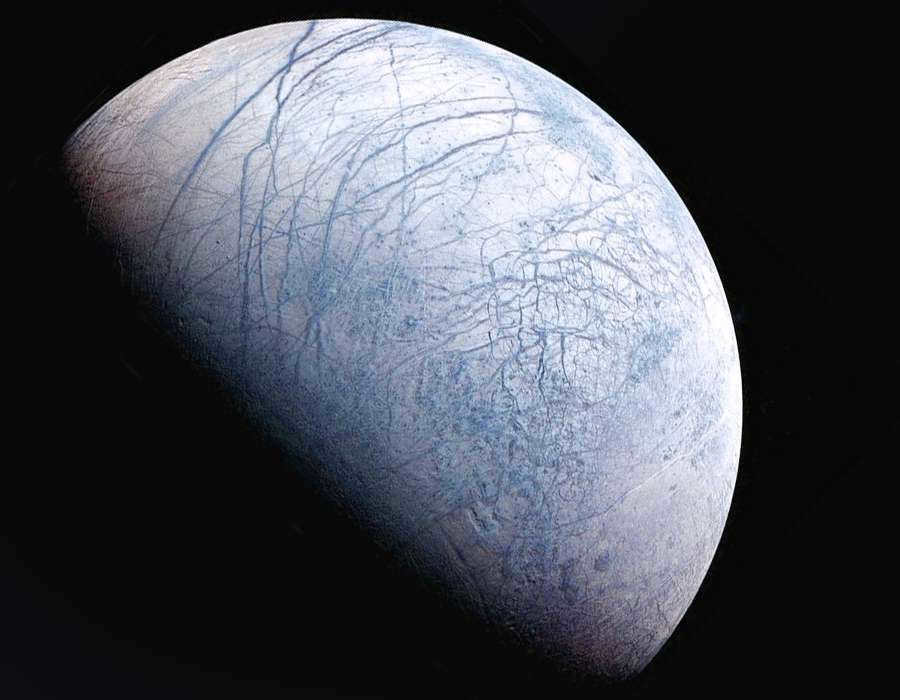
Through a limited number of research conducted on this celestial body, scientists have been able to observe the existence of an ionosphere, leading them to speculate about the presence of an atmosphere. This theory was later confirmed by the Hubble Space Telescope, which detected traces of a small visible atmosphere. The formation of an atmosphere on Europa can be explained by the decomposition of ice into oxygen and hydrogen particles, a process facilitated by solar radiation. However, due to the weak gravitational force, the lighter hydrogen particles are able to escape into space. This discovery has raised questions about the possibility of life on Europa.
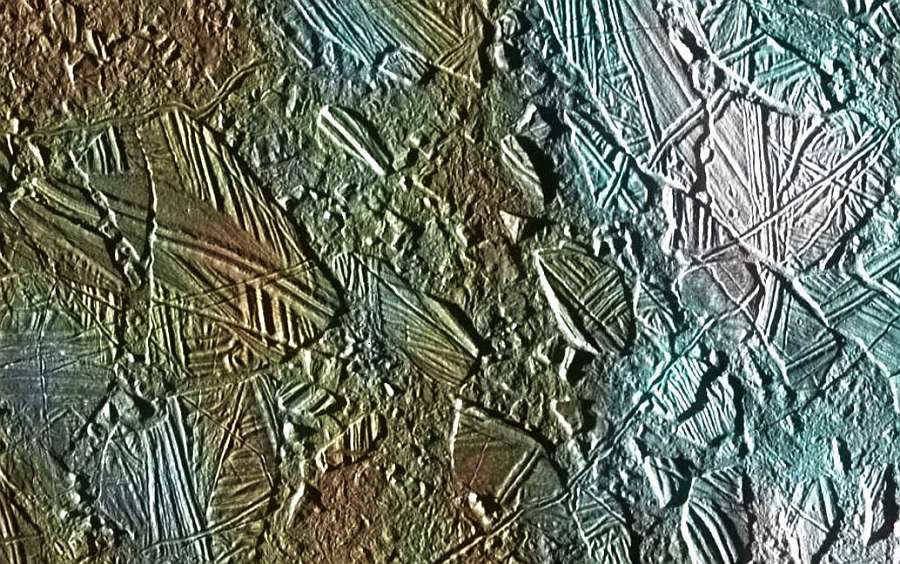
The surface of Europa is adorned with numerous intersecting lines and faults, but is deemed relatively level in comparison to celestial norms, with just a handful of hill-like structures, scattered haphazardly throughout its icy expanse.
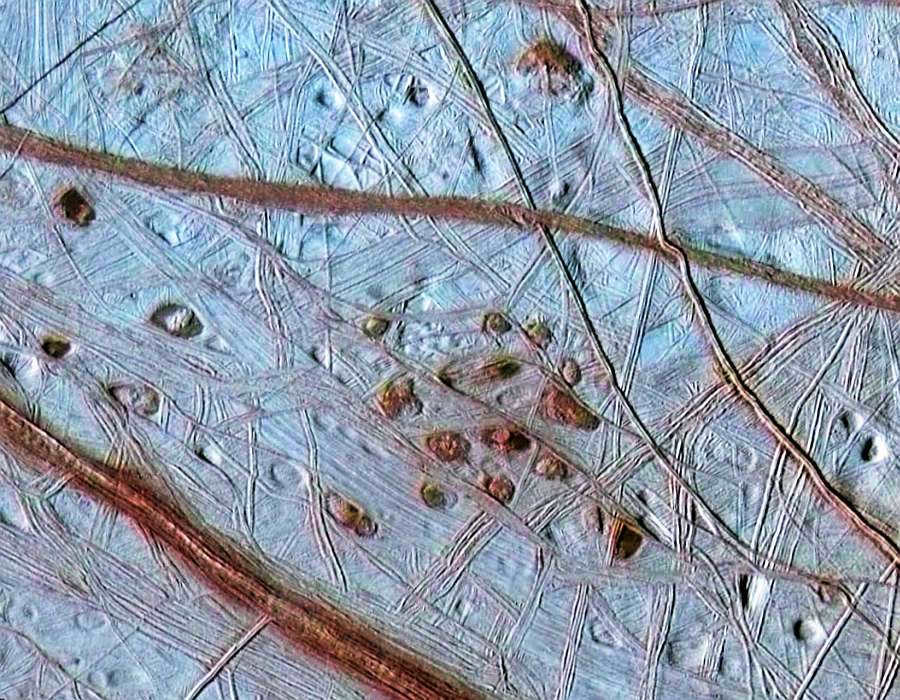
The number of surface craters on Europa is very limited. Currently, only three craters, spanning an area of over 5 kilometers, have been identified. This suggests that the surface is relatively young, estimated to be no older than 30 million years, and displays a high level of geological activity. Additionally, Europa’s surface is heavily exposed to radiation due to its orbit intersecting with Jupiter’s powerful radiation belt.
If you enjoyed this article, don’t forget to share it with your friends!

Europa is considered to be one of the largest moons orbiting the planet Jupiter. With the discovery of water [1] and a subglacial ocean, it has gained attention as a potential candidate for supporting life [2] [3].
General information [ edit ]
The smallest Galilean satellite in terms of size. Situated amidst the orbits of Io and Ganymede. It has a diameter of 3122 km and an average radius of approximately 1560 km. Europa revolves around the planet in a circular orbit with a radius of 670,900 km, completing one revolution in approximately 3.5 Earth days. The orbit is nearly circular (eccentricity = 0.009) and slightly inclined to the plane of the planet’s equator (by 0.466°).
Europa is constantly facing Jupiter on one side due to tidal capture.
Its mass is 4.8017×10^22 kg. The average density is 3.014 ± 0.05 g/cm^3, indicating a relatively high composition of silicate rocks.
The temperatures on Europa vary from 50 K (-223°C) at the poles to 125 K (-148°C) at the equator, with an average temperature of approximately 110 K (-160°C).
There is a small magnetic moment, with a magnetic field strength of approximately 120 nTl.
The satellite’s high albedo, around 0.65, suggests that its surface ice is relatively pure and therefore young.
We can observe flat regions, likely formed by cryovolcanic activity, as well as areas with chaotic topography, areas dominated by linear patterns, ridges (mostly in pairs), and a relatively small number of impact craters, all indicating a youthful surface. Numerous dark stripes, known as lineae, are also present. Additionally, there are peculiar elliptical formations called lenticules. The equator of the satellite may feature icy spires known as penitentes, which can reach heights of up to 15 meters.
As it gets closer to Jupiter, the gravitational pull increases, causing tidal forces to pull the satellite towards the planet. After half of its orbital period, the satellite starts moving away from the planet, causing the tidal forces to weaken and the satellite’s shape to become more circular. Due to the elliptical shape of Europa’s orbit, the tidal humps on the satellite periodically shift in longitude, and due to the tilt of its axis of rotation, they also shift in latitude. These deformations result in the mixing and heating of the subsurface. The energy for this process comes from Jupiter’s rotation around its axis.
Europa formed from the gas and dust disk surrounding Jupiter, during the period when the ice in the disk condensed into satellite material.
Structure [edit]
The organization [edit] of a text refers to its overall framework and arrangement. This includes the way the text is divided into sections, paragraphs, and sentences. The structure of a text helps to determine its coherence and logical flow. It also helps to guide the reader through the content and make it easier to understand. The structure of a text can vary depending on the genre and purpose of the writing. However, most texts have a clear introduction, body, and conclusion. The introduction sets the stage for the topic and provides background information. The body presents the main ideas and supporting evidence. The conclusion sums up the main points and may offer a final thought or recommendation. In addition to these basic elements, texts may also include headings, subheadings, bullet points, and other formatting devices to further enhance their structure and organization. Overall, the structure of a text plays a crucial role in making it coherent, engaging, and easy to navigate for the reader.
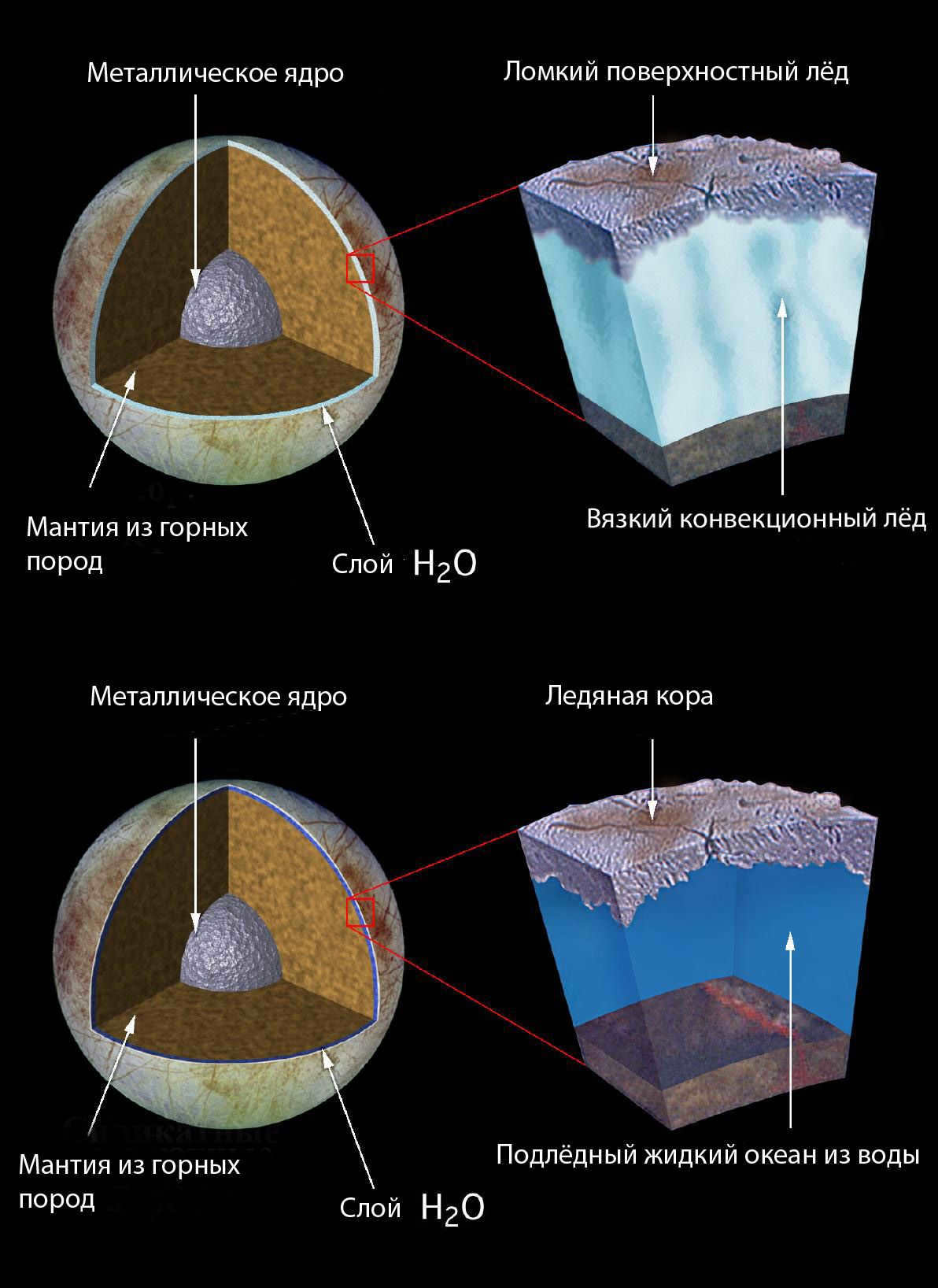
THE LATEST INFORMATION FROM THE DEEP OCEAN IN EUROPE [Jupiter II – the sixth moon of Jupiter] // Sinister Universe / SINISTER SPACE [15:00].
With its predominantly rocky composition, it bears a striking resemblance to Earth’s celestial companions. The external layers, approximately 100 km in thickness, are primarily made up of water, which exists in two distinct forms: a frozen crust spanning 10-30 km and a hidden reservoir of liquid beneath the surface. Deeper still lies a bedrock of rocks, culminating in a potential core composed of a compact blend of metallic elements such as iron and nickel.
The atmospheric pressure at the surface is approximately 0.1 µPa.
The sparse European atmosphere is primarily composed of molecular oxygen (O2) resulting from the breakdown of ice into hydrogen and oxygen due to solar and other forms of radiation (with hydrogen escaping into space). Additionally, atomic oxygen, hydrogen, sodium, and potassium atoms have been detected in the atmosphere. An orbital gas torus is also present.
Therefore, the European atmosphere is formed through the radiolysis of ice.
There exists a rarefied ionosphere (the upper layer of charged particles in the atmosphere) generated by solar radiation and charged particles from Jupiter’s magnetosphere.
Ocean [ edit ]
Europa is known to have a subsurface ocean due to the heat generated by tidal forces.
The most notable characteristic of the ocean is Europa’s magnetic field. It consistently opposes Jupiter’s magnetic field as it is formed by electric currents induced within Europa’s interior by Jupiter’s magnetic field. This suggests the presence of a conductive layer, likely consisting of a salty water ocean.
Another indication of an ocean is the 80° shift between Europa’s crust and its interior.
In 2008, a hypothesis was proposed suggesting that the primary factor responsible for maintaining the ocean in its liquid state is not the elongation of Europa’s orbit, but rather the tilt of its axis.
The thickness of the solid ice crust is believed to be around 10-30 km, while the liquid ocean below is approximately 100 km deep, with a volume of 3×10^18 m^3. Some estimates suggest that the ocean’s depth may range from 20-30 km.
An analysis of the surface composition revealed the presence of various salts, including magnesium sulfate (MgSO4). It is likely that iron and sulfur compounds are also present in Europa’s ocean, and they are expelled through cracks before solidifying. Additionally, there are traces of hydrogen peroxide (H2O2) and potentially strong acids, such as sulfuric acid hydrate.
Researchers have discovered signs of water vapor emissions occurring when geysers forcefully shoot out of fissures in the icy crust. Based on calculations, the vapor is propelled out at a speed of approximately 700 m/s, reaching heights of up to 200 km before descending. The geysers in Europe have an impressive power output of 5 tons per second.
Hypothetical life [ edit ]
Scientists at Caltech reported in early April 2013 that they have discovered significant amounts of hydrogen peroxide on Europa, which could potentially serve as an energy source for bacteria that thrive in extreme conditions.
A theory emerged in March 2013 suggesting that the ocean on Europa is not isolated, but rather interacts with the environment by exchanging gases and minerals with the ice deposits on the surface. This implies that the chemistry of the ocean is diverse and capable of storing energy, increasing the possibility of life.
In the same year, researchers found traces of phyllosilicate clay minerals on Europa, which are believed to have originated from an asteroid. The presence of these minerals further enhances the likelihood of life on Europa.
Some of the molecular oxygen in Europa’s atmosphere remains on its surface and could potentially enter the ocean, contributing to biological processes.
In 2009, Richard Greenberg, a professor at the University of Arizona, conducted a study and determined that Europa’s ocean could potentially support complex life forms due to its significant oxygen levels. In fact, he suggested that Europa’s ocean may have even higher concentrations of oxygen than Earth’s oceans, making it possible for not only microbes but also larger organisms to thrive.
In 2016, scientists observed similarities in the chemical processes occurring in Europa’s ocean compared to those in Earth’s oceans [5].
The existence of hypothetical life on Europa could be attributed to chemosynthesis, similar to the biocenoses found near hydrothermal vents on Earth. It is therefore highly likely that any hypothetical life on Europa would be located near hydrothermal vents on the ocean floor.
Despite these findings, there are compelling arguments suggesting that there is no life on Europa.
To begin with, Europa experiences high levels of radiation as it travels through Jupiter’s formidable radiation belt. The daily dose reaches approximately 540 rem (5.4 Sv) – almost a million times greater than that on Earth.
Nevertheless, the radiation intensity is not uniform:
At the poles of Europa, the radiation level is lower due to the uneven distribution of rays in its orbit. Scientists have discovered that a few centimeters of ice provide sufficient protection against radiation. They have also found that amino acids and other complex organic compounds can survive at depths of 10 to 20 centimeters in low latitudes, and under just 1 centimeter of ice in medium and high latitudes [6].
Furthermore, it has been suggested that “Jupiter’s magnetosphere shields the surface of Europa from cosmic particles” [7].
Furthermore, the ocean of Europa might consist of a corrosive liquid. A 2012 publication raised the possibility that carbon-based life cannot exist in this ocean. Researchers at the University of South Florida, including Matthew Pasek, propose that the high concentration of sulfuric acid, resulting from the oxidation of sulfur-containing minerals in the subsurface, particularly metal sulfides, makes the Europan ocean uninhabitable. They argue that the water’s pH (acidity) there is 2.6 [8].
However, in 2013, scientists from Caltech observed that the Europan ocean contains significant amounts of chlorides, such as sodium chloride (NaCl) and potassium chloride (KCl), similar to Earth’s oceans [9].
Discovery [ edit ]
First observed on January 8, 1610, by G. Galileo.
A multitude of satellite data has been collected by various satellites such as Pioneer-10, Pioneer-11, Voyager-1, Voyager-2, Galileo, Hubble Telescope, and more.
Future endeavors and initiatives [ edit ]
There are plans underway to launch missions to Europa, including JUICE, Europa Clipper, and Laplace-P, as well as a groundbreaking “robotic submarine” designed to explore Europa’s oceans in search of signs of life [10] [11].
Additionally, there have been proposals for colonizing Europa and even terraforming it [12], although these concepts face significant challenges such as intense radiation, low gravity, and other fundamental obstacles. For instance, the Artemis project suggests utilizing igloo-style habitats or establishing bases on the inner side of the icy crust by creating air pockets. Submarine exploration of the ocean is also being considered.
Political scientist and aerospace engineer T. Gangale has created a specialized timetable for the future inhabitants of Europa.
It is more probable that a scientific robotic station will be established on Europa in order to conduct research on its vast oceans.
Sources [ edit ]
- ↑NASA has detected traces of water vapor on the surface of Jupiter’s moon Europa.
- ↑Could Europa, one of Jupiter’s moons, harbor life in its ocean?
- ↑Europa’s ocean has been deemed habitable.
- ↑Scientists have found clay minerals on the surface of Jupiter’s moon.
- ↑NASA states that Europa’s ocean has terrestrial properties and composition.
- ↑Life on Jupiter’s moon may exist several centimeters beneath the surface.
- ↑Jupiter shields its moon from cosmic rays.
- ↑Life on Europa is rather acidic.
- ↑Researchers have made the fascinating revelation that the surface of Jupiter’s moon is coated in sodium chloride, commonly known as table salt.
- ↑Both NASA and ESA are collaborating on a mission to send a lander to Europa, one of Jupiter’s moons.
- ↑A group of Russian scientists have embarked on a mission to explore the possibility of life on Jupiter’s satellite.
- ↑A thought-provoking article titled “Terraforming Europa” has been published on Universe Today, speculating on the potential of transforming Europa’s environment to make it suitable for human habitation.
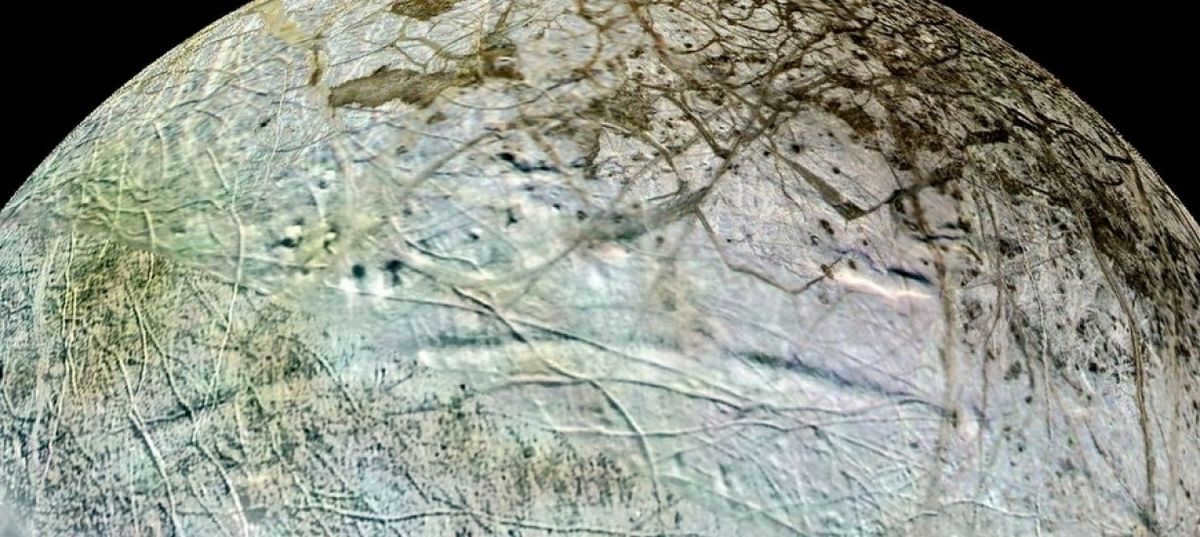
Europa, a moon orbiting Jupiter, is an extraterrestrial entity enveloped in a shell of frozen water, concealing a vast expanse of liquid water beneath. Scientists estimate that this subterranean ocean extends approximately 30 kilometers deep, with layers of solid rock and a metallic core lying even deeper.
Europa completes its orbit around Jupiter at a staggering speed of 50,000 km/h, completing one revolution every three and a half days. Similar to Earth’s moon, Europa maintains a synchronous rotation, always presenting the same face to its parent planet. In terms of its composition, this celestial satellite bears resemblance to the terrestrial planets within our own solar system.
While Europa does possess an atmosphere, it is relatively thin and tenuous. Interestingly, this atmosphere does contain traces of oxygen. However, due to its low density, the surface pressure on Europa is incredibly minuscule, measuring at about one billionth of Earth’s atmospheric pressure.
Many of Jupiter’s Galilean satellites, including Europa, are believed to have originated from a circumplanetary disk composed of gas and dust.
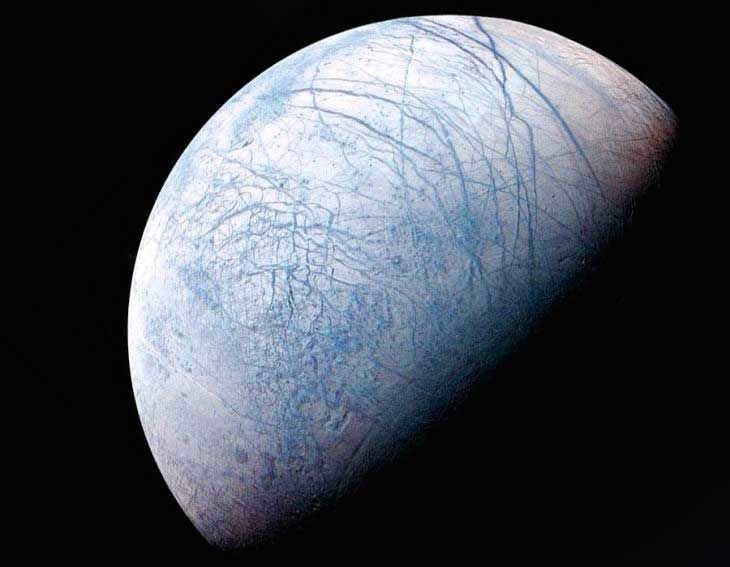

Europa’s Terrain
Europa’s surface features include ridges and craters, although they are relatively scarce compared to other celestial bodies. The highest hills on Europa reach a maximum height of 100 meters. Interestingly, Europa’s surface is predominantly flat, making it quite unique among similar objects. The ice covering the surface is incredibly smooth and pristine, suggesting constant rejuvenation.
The majority of Europa’s surface is covered by vast ice plains, likely formed as a result of cryovolcanic eruptions. The ridges on Europa’s surface are a result of ice accumulation, while the craters have formed due to infrequent meteorite impacts.
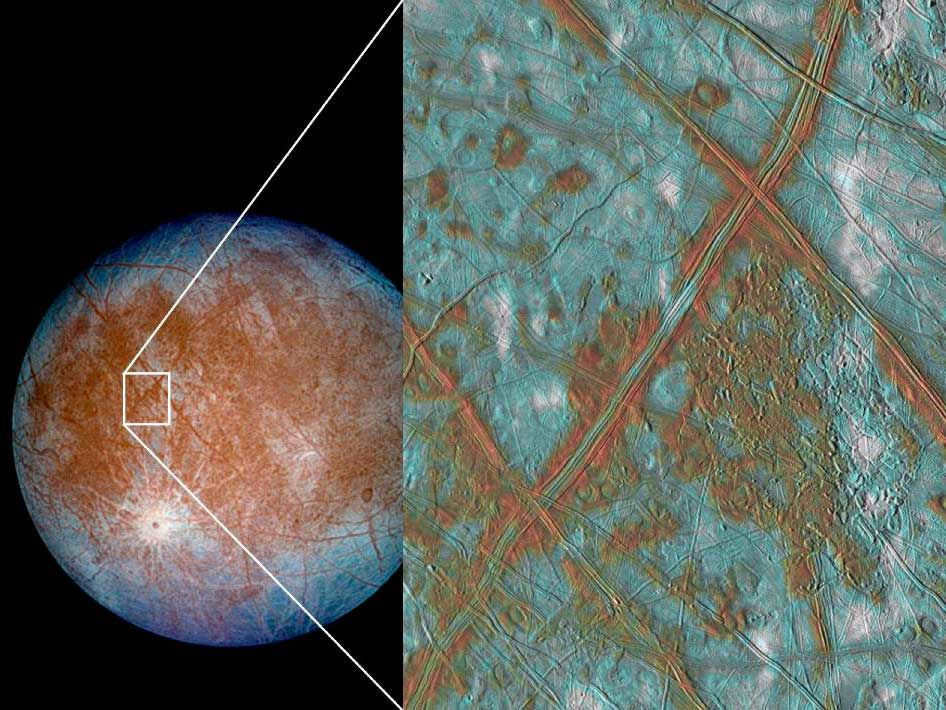

The reason why Europa has so few craters is because its surface undergoes constant renewal. In cosmic terms, Europa is relatively young, estimated to be somewhere between 20 and 180 million years old, although an exact age is impossible to determine. Because Europa is covered in ice, the surface temperature remains extremely low, never exceeding -150°C.
In addition to ice, there are also deposits of salt, sulfur, and iron on Europa. These deposits give the cracks in the ice crust a reddish color, which can be observed in numerous spots across the surface. Some theories suggest that these spots were formed as a result of the impact of warmer ice layers beneath the colder outer layers.
Ocean
Given that Europa possesses its own magnetic field, a conductive layer is required. This particular requirement is most fittingly met by saltwater deposits, leading scientists to conclude the existence of an ocean on this satellite. However, this is not the only evidence available: the crust of Europa has experienced an 80 ° shift, indicating that it is not firmly attached to its underlying structure.
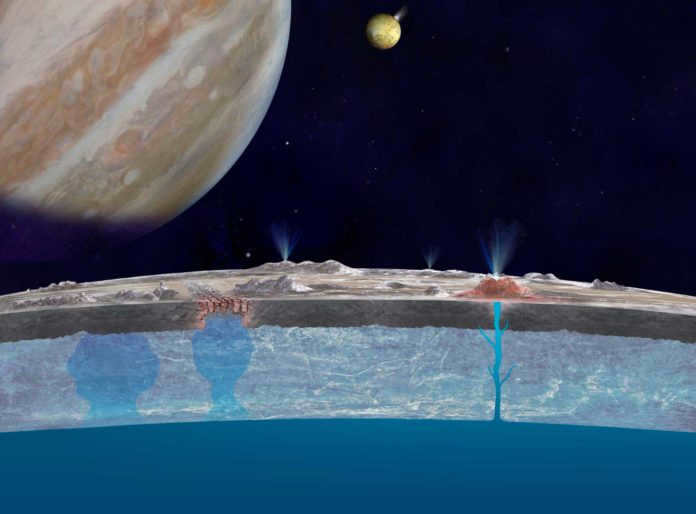
Jupiter’s gravitational force is believed to have played a major role in the formation of the ocean on Europa. Speculations suggest that the composition of the ocean may be enriched with various chemical elements.
Could there be life on Europa?
The presence of liquid water on Europa offers hope for the existence of life, although it does not guarantee it. It is possible that the ocean is home to microorganisms and bacteria that originated there. Additionally, there is a possibility of life existing beneath the icy crust, where organisms could be attached, similar to algae. However, due to the extreme cold and high salinity of the ocean, the chances of life emerging there are extremely slim.
In the past, Europa unveiled the presence of hydrogen peroxide, potentially serving as an energy resource for bacteria. Furthermore, the detection of certain clay minerals, potentially transported by meteorites, adds to the speculation about the potential emergence of life forms.
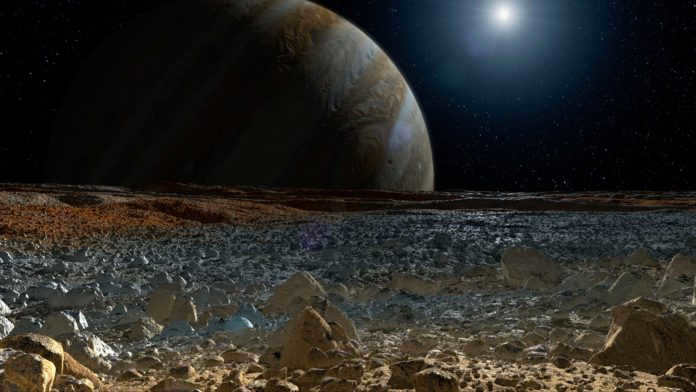
Ice exploration
Exploring the icy terrain of Europa requires a unique approach. A specially designed sailboat equipped with a sail capable of harnessing the power of the solar wind is essential. It is crucial to have adequate protection against the high levels of radiation present on Europa, as even a brief exposure can be lethal. The sailboat should have a wide and elongated hull to effectively navigate through the icy surface.
It is important to note that the temperature on Europa is extremely low, making it highly advisable to remain inside the sailboat at all times. Care must be taken to navigate past cracks and hummocks, and to avoid the red spots that are scattered throughout the landscape. While the scenery may resemble Antarctica on Earth, it is important to remember that the local atmosphere is not breathable.
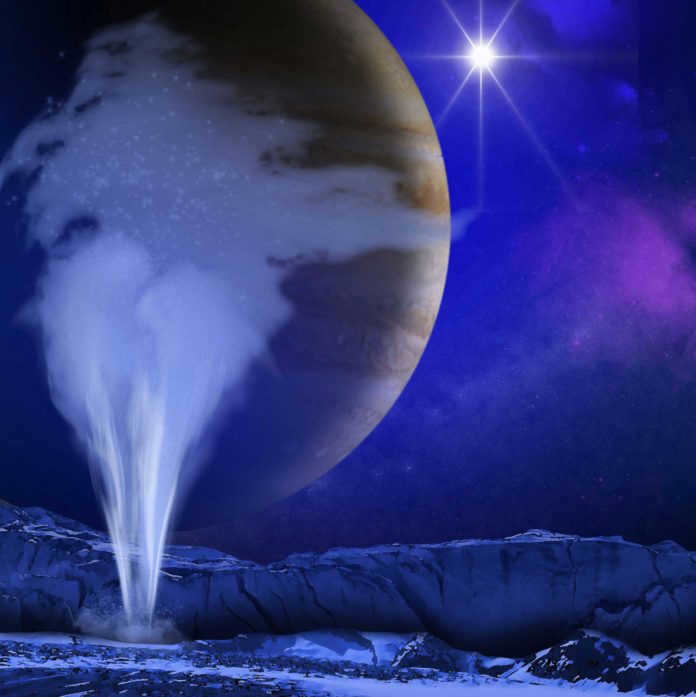
Discovering Europe
Europe was first encountered in 1610 by Galileo Galilei and Simon Marius, independently of each other. Although Marius’ discovery remains unconfirmed. The initial photographs were taken in the 1970s by the Voyager spacecraft, providing some insight into its surface and composition, suggesting the existence of liquid water on the moon.
In 1994, scientists detected the presence of oxygen on Europa. By the turn of the century, the presence of radiation was also observed.
Until 2003, the Galileo probe conducted a thorough investigation of Europa, coming as close as 201 kilometers to its surface. It once again provided evidence supporting the theory of an ocean’s existence. In order to prevent any potential contamination of Europa by terrestrial microorganisms, Galileo was intentionally destroyed in Jupiter’s atmosphere.
In 2007, the New Horizons probe, on its way to Pluto, captured even clearer images of this moon.

